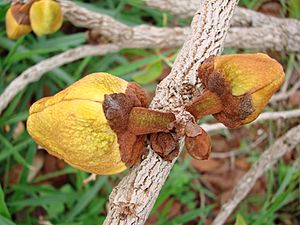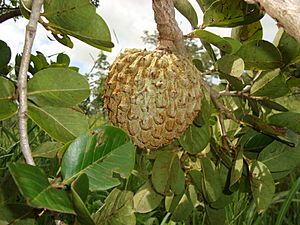Marolo facts for kids
Quick facts for kids Marolo |
|
|---|---|
 |
|
| Scientific classification | |
| Genus: |
Annona
|
| Species: |
crassiflora
|
Annona crassiflora, often called marolo, is a unique flowering plant. You might also hear it called araticum cortiça, araticum do cerrado, or bruto. Its flowers look a bit like jellyfish wearing hats! The fruits are sweet and have a very rough skin. This plant grows naturally in Brazil and Paraguay. People who live in the Brazilian Cerrado region love to eat its fruit. Even though it could be grown more widely, it's not a common farm crop yet.
Contents
About the Marolo Tree
The marolo tree usually grows to be about 6 to 8 meters (20 to 26 feet) tall. Its top, called the crown, can spread out 2 to 4 meters (6 to 13 feet) wide. It belongs to the Annonaceae plant family. You can find marolo trees spread out in different parts of the Brazilian Cerrado. This plant prefers savannah areas that aren't too dry. It's especially popular in Minas Gerais, where the fruit is a local favorite. You can also find it in Mato Grosso do Sul, parts of São Paulo, and isolated areas of Goiás, Mato Grosso, Tocantins, Maranhão, and eastern Bahia.
Roots, Trunk, and Leaves
The marolo tree has deep roots that go far into the soil. This helps it find water and nutrients. Its main trunk is straight, but the smaller branches are often crooked. The bark is thick and corky, and it tends to chip off. The leaves are oval-shaped and feel a bit leathery.
The marolo tree produces yellow-greenish flowers between November and January. These flowers are pollinated by insects, especially a type of beetle called the Ciclocéfalo beetle (Cyclocephala atricapilla). The fruits grow in clusters and can weigh up to 4.5 kilograms (nearly 10 pounds)! When ripe, their skin is green-brown. The seeds inside are sometimes used as a traditional remedy for diarrhea.
Marolo Fruits
Marolo fruits can be over 15 centimeters (6 inches) wide and weigh up to 2 kilograms (about 4.4 pounds). They contain many seeds, each about 1.5 centimeters (0.6 inches) long. When you open a marolo fruit, you'll find a creamy pulp inside. It has a very strong smell and taste, quite different from a custard apple.
People in the Brazilian Cerrado region consider marolo a special treat. You can often find it sold in street markets. People enjoy it fresh or use it to make many delicious things. These include cocktails, cakes, cookies, crackers, popsicles, ice cream, jams, and other sweets.
The marolo tree starts growing fruit in November. The fruits then ripen between February and April. In Minas Gerais, Brazil, this ripening time is often linked to the Lent season. When a marolo fruit is perfectly ripe, it falls to the ground under the tree. It gives off a strong, unique smell. These fallen fruits are the best quality for eating. If you pick the fruit directly from the tree, it might not ripen properly and won't taste as good.
Reproduction of Marolo
The pollen of the marolo plant is released in groups of four.
Protecting Marolo Trees
Sadly, the increasing clearing of the Cerrado region is causing problems for marolo trees. Also, their seeds take a very long time to sprout, sometimes up to 300 days! These things have led to a big drop in the number of marolo trees in Minas Gerais.
However, there's good news! Professor João Afonso de Carvalho from the Federal Agrotechnical School in Machado has done important scientific research and cultivation work. His efforts are helping to save marolo trees in the region. The places with the most marolo trees are Carvalhópolis and Paraguaçu.
See also
 In Spanish: Marolo para niños
In Spanish: Marolo para niños



